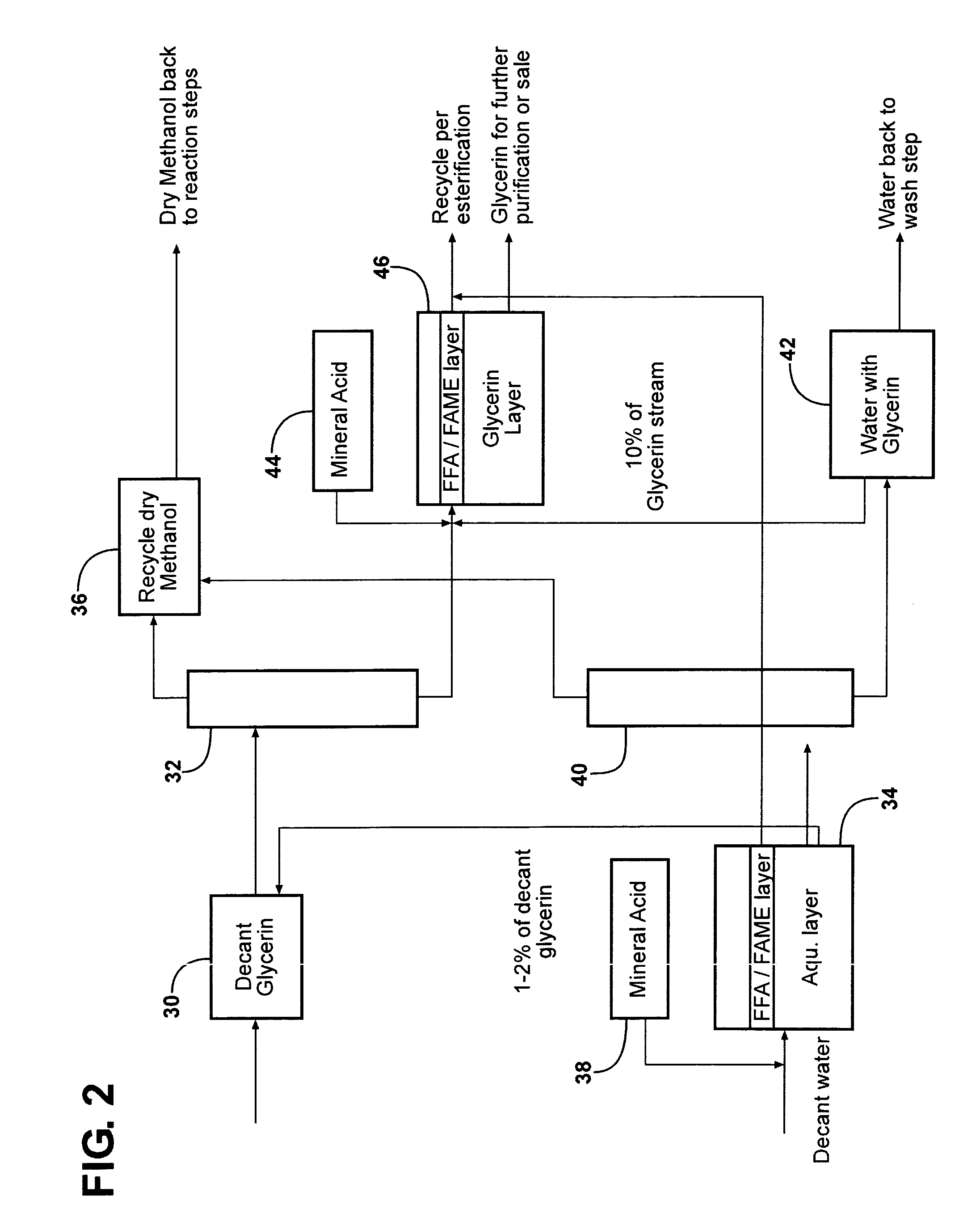Purification of glycerin obtained as a bioproduct from the transesterification of triglycerides in the synthesis of biofuel
a technology of glycerin and bioproduct, which is applied in the purification/separation of oxygen-containing compounds, organic chemistry, and the preparation of oxygen-containing compounds, etc., can solve the problem of significant drop in the bottom temperature of addition
- Summary
- Abstract
- Description
- Claims
- Application Information
AI Technical Summary
Benefits of technology
Problems solved by technology
Method used
Image
Examples
example 1
[0058]This example uses principles of the present invention to remove MeOH from crude glycerin using distillation in the presence of a limited amount of water. The crude glycerin treated in this example was the glycerin bottom obtained from the transesterification of soybean oil with methanol. This crude glycerin had the following characteristics:
[0059]
TABLE 1pH12Water (wt. % by K.F.)*0.26Composition, wt %MeOH47.5Glycerin41.1Esters11.3Soap, ppm as Na-oleate by titration112000*K.F. refers to Karl Fischer titration according to ASTM D789.
[0060]The limited amount of water makes the methanol removal easier (compared to a wetter glycerin distillation by avoiding excessive foaming (foaming requires water). Additionally, if too much water were to have been present during distillation the soap present in the crude glycerin could cause coking and plugging around the reboiler.
[0061]Continuous distillation was used to strip the methanol from the crude glycerin. For purposes of this example, it...
example 2
[0066]This example describes further purification of the crude glycerin processed in accordance with Example 1. After the MeOH was removed from the crude glycerin, the glycerin had a pH of 12 and still contained soap and methyl esters. By acidifying the crude glycerin, the soap could be converted into FFA. The FFA and FAME (fatty acid methyl ester) could be separated from the glycerin and recycled. For this example, a specification was applied in which the recovered, purified glycerin would include a maximum of 18 weight percent water based on the total weight of glycerin and water.
[0067]In order to convert the sodium salt of fatty acids (i.e., the soap) to free fatty acid, the crude glycerin acidified to pH 3-4. H2SO4 was added slowly into the glycerin until pH ˜3.5. Overall, 2.7 weight percent H2SO4 (98%) was used. After the acid was added, 14% by weight water was added as well based on the weight of the crude glycerin. The reaction took place at 50° C. for ˜18 hours. The amount o...
example 3
[0071]A limited amount of water is added to a crude glycerin feedstock obtained from the synthesis of biodiesel having to provide an admixture having the following range of characteristics:
[0072]
Water1-3%Soap, as Sodium Oleate15-25%FAME1-5%Methanol15-30%Glycerin45-65%pH10-12
[0073]The admixture is then distilled to strip methanol. The distillation is done in either mild steel or stainless steel units of 3-6 ft diameter at either atmospheric pressure or moderate overpressure or vacuum. Feed enters the column at or below the middle of the distillation tower. At the head, a Methanol stream with 500 ppm water is recovered. This dry methanol is fit for reuse in a biodiesel synthesis process.
[0074]The bottom temperature ranges between 160° C. and 190° C. depending mostly upon the amount of added water. A glycerin stream is taken from the bottom. This stream contained a maximum of 0.5% by weight Methanol. Despite the high amount of soap present, the stream is substantially homogenous. Th...
PUM
| Property | Measurement | Unit |
|---|---|---|
| pressure | aaaaa | aaaaa |
| temperature | aaaaa | aaaaa |
| temperature | aaaaa | aaaaa |
Abstract
Description
Claims
Application Information
 Login to View More
Login to View More - R&D
- Intellectual Property
- Life Sciences
- Materials
- Tech Scout
- Unparalleled Data Quality
- Higher Quality Content
- 60% Fewer Hallucinations
Browse by: Latest US Patents, China's latest patents, Technical Efficacy Thesaurus, Application Domain, Technology Topic, Popular Technical Reports.
© 2025 PatSnap. All rights reserved.Legal|Privacy policy|Modern Slavery Act Transparency Statement|Sitemap|About US| Contact US: help@patsnap.com


